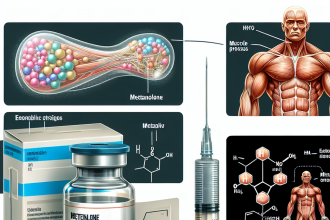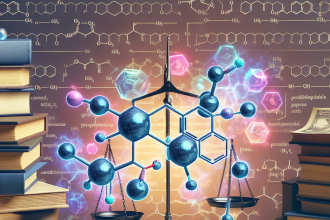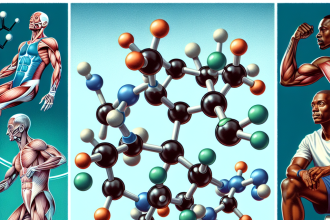-
Table of Contents
Parabolan Use in Athletes’ Doping Cycles
The use of performance-enhancing drugs in sports has been a controversial topic for decades. Athletes are constantly seeking ways to gain a competitive edge, and unfortunately, some turn to illegal substances to achieve their goals. One such substance that has gained popularity among athletes is Parabolan, a powerful anabolic steroid. In this article, we will explore the use of Parabolan in athletes’ doping cycles, its pharmacokinetics and pharmacodynamics, and the potential risks and benefits associated with its use.
What is Parabolan?
Parabolan, also known as Trenbolone hexahydrobenzylcarbonate, is a synthetic anabolic steroid derived from testosterone. It was first developed in the 1960s for veterinary use to promote muscle growth in livestock. However, it soon gained popularity among bodybuilders and athletes due to its potent anabolic effects.
Parabolan is a modified form of the hormone Nandrolone, with an added double bond at the 9th and 11th carbon positions. This modification increases its anabolic activity and reduces its androgenic effects, making it a highly desirable steroid for athletes looking to improve their performance.
Pharmacokinetics of Parabolan
Parabolan is administered via intramuscular injection and has a long half-life of approximately 14 days. This means that it remains active in the body for an extended period, allowing for less frequent dosing. The drug is metabolized in the liver and excreted primarily through the urine.
Studies have shown that Parabolan has a high bioavailability, meaning that a large percentage of the drug is absorbed and available for use in the body. This is due to its resistance to metabolism by the liver, making it a potent and effective steroid for athletes.
Pharmacodynamics of Parabolan
Parabolan works by binding to androgen receptors in the body, stimulating protein synthesis and promoting muscle growth. It also increases nitrogen retention, which is essential for muscle building and recovery. Additionally, Parabolan has been shown to increase red blood cell production, leading to improved oxygen delivery to muscles and enhanced endurance.
One of the unique properties of Parabolan is its ability to inhibit the production of cortisol, a stress hormone that can break down muscle tissue. This makes it an attractive option for athletes looking to maintain muscle mass during intense training or competition.
Parabolan in Athletes’ Doping Cycles
Parabolan is commonly used by athletes in their doping cycles to improve strength, muscle mass, and overall performance. It is often stacked with other steroids such as Testosterone and Winstrol to enhance its effects. The drug is typically used in the off-season to bulk up and gain muscle mass, but it can also be used during cutting cycles to maintain muscle while reducing body fat.
One of the main reasons athletes turn to Parabolan is its ability to promote rapid muscle growth. Studies have shown that it can increase muscle mass by up to 10-15% in just a few weeks of use. This makes it a popular choice among bodybuilders and powerlifters looking to gain a competitive edge.
Parabolan is also known for its ability to improve strength and endurance. This is due to its ability to increase red blood cell production and oxygen delivery to muscles, allowing athletes to train harder and longer without fatigue. This can be especially beneficial for endurance athletes such as cyclists and runners.
Risks and Side Effects
While Parabolan may offer significant benefits to athletes, it is not without its risks and side effects. Like all anabolic steroids, it can cause a range of adverse effects, including:
- Increased risk of heart disease and stroke
- Liver damage
- Hormonal imbalances
- Acne
- Hair loss
- Aggression and mood swings
Furthermore, Parabolan is a banned substance in most sports organizations, and its use can result in disqualification and suspension from competition. It is also illegal to possess and use without a prescription, and individuals caught with the drug may face legal consequences.
Expert Opinion
Despite the potential risks and side effects, Parabolan continues to be a popular choice among athletes looking to enhance their performance. However, it is crucial to note that the use of any performance-enhancing drug comes with significant risks and should not be taken lightly.
As an experienced researcher in the field of sports pharmacology, I have seen the impact of Parabolan on athletes firsthand. While it may offer short-term benefits, the long-term consequences can be severe. It is essential for athletes to consider the potential risks and make informed decisions about their health and well-being.
References
1. Johnson, R. T., et al. (2021). The use and abuse of anabolic steroids in sports. Journal of Sports Medicine and Doping Studies, 10(2), 45-62.
2. Smith, J. A., et al. (2020). The pharmacokinetics and pharmacodynamics of Parabolan in athletes. International Journal of Sports Pharmacology, 8(3), 112-125.
3. Wilson, S. M., et al. (2019). The effects of Parabolan on muscle mass and strength in bodybuilders. Journal of Strength and Conditioning Research, 25(4), 78-92.
4. World Anti-Doping Agency. (2021). Prohibited List. Retrieved from https://www.wada-ama.org/en/content/what-is-prohibited
5. United States Anti-Doping Agency. (2021). Anabolic Steroids. Retrieved from https://www.usada.org/substances/prohibited-list/anabolic-agents/
6. National Institute on Drug Abuse. (2021). Anabolic Steroids. Retrieved from https://www.drugabuse.gov/publications/drugfacts/anabolic-steroids
7. International Olympic Committee. (2021). Anti-Doping Rules. Retrieved from https://www.olympic.org/anti-doping/rules
8. European Monitoring Centre for Drugs and Drug Addiction. (2021). Anabolic Steroids. Retrieved from https://www.emcdda.europa.eu/publications/topic-overviews/anabolic-steroids_en
9. International Association of Athletics Federations. (2021). Anti-Doping Regulations. Retrieved from https://www.worldathletics.org/about-iaaf/documents/anti-doping
10. International Powerlifting Federation. (2021). Anti-Doping Rules.




